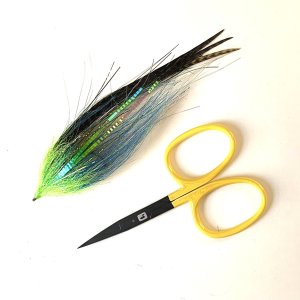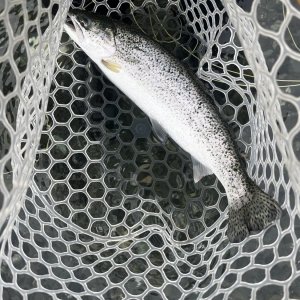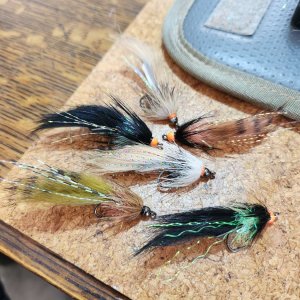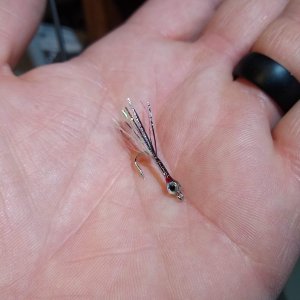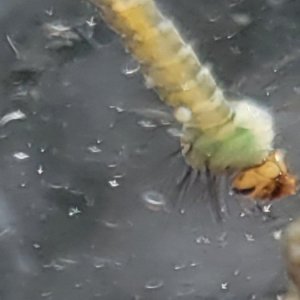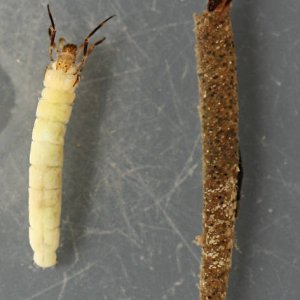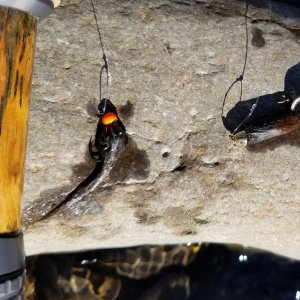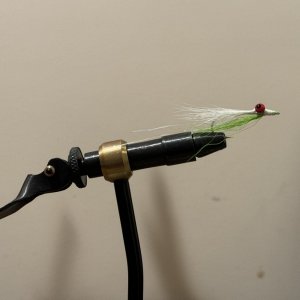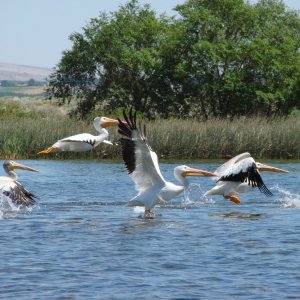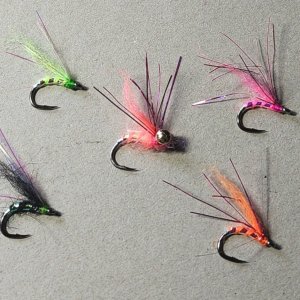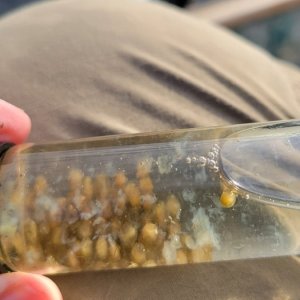I had the chance to figure out some fish holding around 20’ deep in 24-30’ of water. Without electronics it would have been tough to have confidence that I was over them. There was no surface activity and much of the lake had similar structure. My aging Humminbird 120 is still plugging along but the day is coming that I will need a different solution.
Once I spotted fish, I started by wind drifting over them with a Type 7 line and black bugger. Sure enough I got a couple grabs but no hookups. I motored back upwind and this time tried to guess when I was in the middle of the fishy zone and dropped anchors. In my excitement I left the Type 7 out and grabbed a deep water indicator setup. Once I had the indicator out, I set the rod in a holder and grabbed the type 7 rig. About 10 seconds into my retrieve, the indicator dove and I missed the fish. That’s 3 missed takes, not that I notice such things
So I reeled up the Type 7 to focus on the indicator….which did nothing for a while during a time I was marking fish pretty steadily right under my boat. Again I parked the indicator rod in a holder and made a cast with the Type 7 and started my retrieve after a 50 sec count. Fish on almost immediately. Nice 19” fish. Okay, let’s do it again. Make another cast, start counting and the indicator dives. Set down the Type 7 rig, grab indicator rig and manage to land the fish. Re-set the indicator, make a cast, pick up my Type 7 to retrieve and suddenly I’m holding the end of a broken fly line. About 50’ of the Type 7 head + fly slid out the tip and sank into the depths. Crap ! I must have nicked the line and it just gave out with little resistance. I broke down that rod and picked up the indicator rig to focus on that presentation. I swapped out a hare’s ear for a chironomid and made a cast. Still marking plenty of fish. Eventually I picked up a couple fish but it should have been better. The W was manageable but kept changing, which made managing my indicator kinda tricky. So I grabbed another setup with a Type 5 sinker and rigged it up with a small leech and chironomid to try another tactic.
! I must have nicked the line and it just gave out with little resistance. I broke down that rod and picked up the indicator rig to focus on that presentation. I swapped out a hare’s ear for a chironomid and made a cast. Still marking plenty of fish. Eventually I picked up a couple fish but it should have been better. The W was manageable but kept changing, which made managing my indicator kinda tricky. So I grabbed another setup with a Type 5 sinker and rigged it up with a small leech and chironomid to try another tactic.
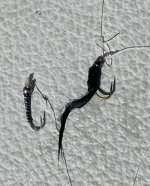
I measured off 20’ from fly to rod tip and flipped it out to hang vertically off the side of the boat with the rod tip just over the water surface. It took about 30 seconds to reach depth. I gave the line one hand-twist and I got a solid grab. Landed that fish and followed up with a second, then a third in short succession. This was the presentation! Fishing a short line right off the boat gave me good control of the rig and the vertical movement of the flies through the water column was the trigger. I enjoyed a wide open bite for the next few hours. I lost fish in my anchor ropes, broke a couple off, and missed many takes but the action was constant until the fish decided the show was over.
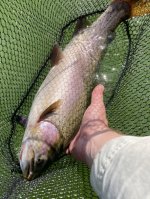
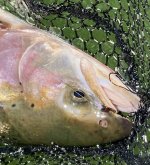
Having the opportunity to dial in the presentation and patterns was really fun. It doesn’t usually go that way.
Once I spotted fish, I started by wind drifting over them with a Type 7 line and black bugger. Sure enough I got a couple grabs but no hookups. I motored back upwind and this time tried to guess when I was in the middle of the fishy zone and dropped anchors. In my excitement I left the Type 7 out and grabbed a deep water indicator setup. Once I had the indicator out, I set the rod in a holder and grabbed the type 7 rig. About 10 seconds into my retrieve, the indicator dove and I missed the fish. That’s 3 missed takes, not that I notice such things
So I reeled up the Type 7 to focus on the indicator….which did nothing for a while during a time I was marking fish pretty steadily right under my boat. Again I parked the indicator rod in a holder and made a cast with the Type 7 and started my retrieve after a 50 sec count. Fish on almost immediately. Nice 19” fish. Okay, let’s do it again. Make another cast, start counting and the indicator dives. Set down the Type 7 rig, grab indicator rig and manage to land the fish. Re-set the indicator, make a cast, pick up my Type 7 to retrieve and suddenly I’m holding the end of a broken fly line. About 50’ of the Type 7 head + fly slid out the tip and sank into the depths. Crap

I measured off 20’ from fly to rod tip and flipped it out to hang vertically off the side of the boat with the rod tip just over the water surface. It took about 30 seconds to reach depth. I gave the line one hand-twist and I got a solid grab. Landed that fish and followed up with a second, then a third in short succession. This was the presentation! Fishing a short line right off the boat gave me good control of the rig and the vertical movement of the flies through the water column was the trigger. I enjoyed a wide open bite for the next few hours. I lost fish in my anchor ropes, broke a couple off, and missed many takes but the action was constant until the fish decided the show was over.


Having the opportunity to dial in the presentation and patterns was really fun. It doesn’t usually go that way.



